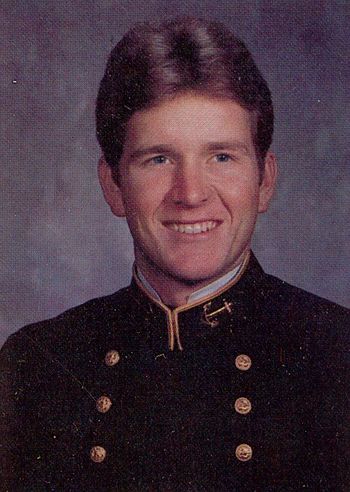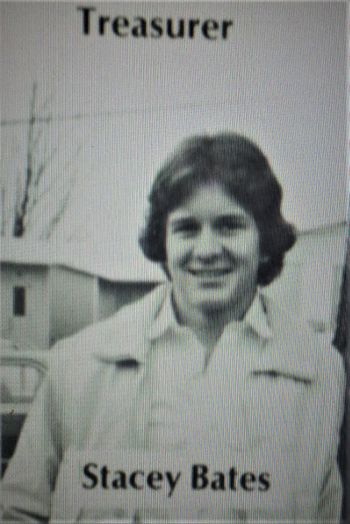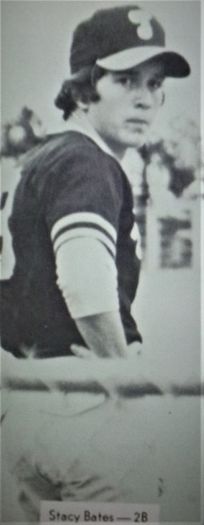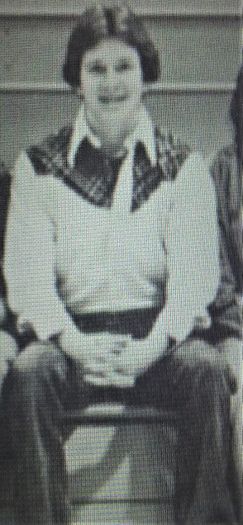JOHN S. BATES, LCDR, USN
John Bates '84
Lucky Bag
From the 1984 Lucky Bag:
John Stacy Bates
Chattanooga, Tennessee
Stace
This good old boy came busting into Annapolis on I-Day and hasn't slowed down one bit since he got here. Plebe year went by pretty smooth down the SHAFT until Stace decided he couldn't live without that country music and got caught with his radio. Then came that annual "Spring Fever" of his and he made the mistake of doing a little partying out in town after taps one night. That was a heckuva Commissioning Week… Youngster year looked like a time to just sit back and stay out of everyone's way. Unfortunately we got in the way of a certain SEAL officer one night and Stace ended up paying for it for 2 years. He also liked to have a good time at the Army-Navy game, occasionally going a little overboard (Mr. Morlock still doesn't like you for that!) To say that this guy loved to workout would be an understatement. He had a permanent spot in the weightroom and when he wasn't there he could be found under the desk doing situps or against the wall doing pushups. There is no doubt that he could be very happy if the only things he had were a weight bench, a blender, and an unlimited supply of milk and granola cereal. Stace was also very dedicated when it came to academics but he firmly believed in getting his sleep, another area in which he excelled.
Stace didn't get his pilot billet because of his eyes but P-cola is getting a winner in this NFO. We're all going to miss him and wish him the best of luck. You've been a super friend Stace, keep in touch and keep on pumpin' bubba!!

John Stacy Bates
Chattanooga, Tennessee
Stace
This good old boy came busting into Annapolis on I-Day and hasn't slowed down one bit since he got here. Plebe year went by pretty smooth down the SHAFT until Stace decided he couldn't live without that country music and got caught with his radio. Then came that annual "Spring Fever" of his and he made the mistake of doing a little partying out in town after taps one night. That was a heckuva Commissioning Week… Youngster year looked like a time to just sit back and stay out of everyone's way. Unfortunately we got in the way of a certain SEAL officer one night and Stace ended up paying for it for 2 years. He also liked to have a good time at the Army-Navy game, occasionally going a little overboard (Mr. Morlock still doesn't like you for that!) To say that this guy loved to workout would be an understatement. He had a permanent spot in the weightroom and when he wasn't there he could be found under the desk doing situps or against the wall doing pushups. There is no doubt that he could be very happy if the only things he had were a weight bench, a blender, and an unlimited supply of milk and granola cereal. Stace was also very dedicated when it came to academics but he firmly believed in getting his sleep, another area in which he excelled.
Stace didn't get his pilot billet because of his eyes but P-cola is getting a winner in this NFO. We're all going to miss him and wish him the best of luck. You've been a super friend Stace, keep in touch and keep on pumpin' bubba!!
Loss
Stacy was lost on January 29, 1996 when the F-14 Tomcat he was piloting crashed into a house near Nashville, Tennessee. His radar intercept officer was also killed, as were three people on the ground.
Other Information
From the April 1996 issue of Shipmate:
LCDR John Stacy Bates was killed on 29 January 1996 in the crash of an F-14 Tomcat. He had just taken off from the Nashville airport on his way back to NAS Miramar when the crash occurred. A memorial service was held on 1 February at the NAS Miramar chapel and he was buried on 7 February at the Chattanooga National Cemetery in Chattanooga, Tennessee.
Stacy was born on 20 July 1962 to Les and Peggy Bates in Nashville, Tennessee. He spent most of his childhood growing up in Valdosta, Georgia, before moving to Chattanooga in 1977. He graduated from Tyner High School in 1980, where he was a star athlete, and was appointed to the Naval Academy with the Class of 1984. A member of the 15th company, he played baseball, lightweight football and several intramural sports while at the Academy.
After graduation Stacy proceeded to NAS Pensacola to commence Naval Flight Officer training. He earned his NFO wings in October 1985 and began his training as a Radar Intercept Officer in the F-14 Tomcat at NAS Miramar.
Upon completion of the RAG, Stacy reported to the "Aardvarks" of VF-114. After a 3 year tour with VF-114 he was selected for the pilot transition program and underwent training at NAS Whiting Field and NAS Meridian. He earned his pilot wings in August 1991 and once again returned to the F-14 RAG at Miramar.
Stacy then reported to the "Black Lions" of VF- 213 in October 1992. While assigned to VF-213, he was selected to attend the prestigious Navy Fighter Weapons School (TOPGUN). He additionally completed his second and third deployments to the Western Pacific/Arabian Gulf, participating in Operation Southern Watch, where he flew combat missions over Iraq.
Stacy's personal awards include the Air Medal, Navy Commendation Medal, Navy Achievement Medal, Armed Forces Expeditionary Medal, Kuwait Liberation Medal, Southwest Asia Service Medal and numerous campaign ribbons.
Sadly Stacy leaves behind his loving wife Christina and beautiful 12 week old daughter Savannah. He had many great achievements in his life, but none made him prouder than his marriage and the birth of his daughter.
Stacy, affectionately known as "Sprout", will always be remembered by his friends and classmates for his deep concern for and unwavering dedication to his fellow man and his country. His southern charm enabled him to quickly make friends everywhere he went and he truly touched the lives of those he met. He was an exceptional husband, father, son, friend and shipmate. He will be deeply missed by us all.
Memorial donations for a college fund may be sent to: "Savannah Bates Educational Fund", c/o First American Bank, P.O. Box 11589, Chattanooga, Tennessee 37401.
Jon Nowicki '84
From researcher Kathy Franz:
Graduated in 1980 from Tyner High School. AMBITION: Go to Luckenbach, Texas with Willie and Waylon and the boys. Key Club; Beta Club; National Honor Society; Fellowship of Christian Athletes; Treasurer of Student Council and Senior Class; Basketball Team; Bachelor of Ugliness Court; Christmas Court; Valentine Court; Twirp King; Homecoming Court; RAM REVUE: Naval Academy Scholarship.
He is buried in Tennessee.
From Philly.com on April 17, 1996:
WASHINGTON — Two of the three recent crashes of F-14 fighters that killed a total of seven people this year were caused by pilot error, Navy officials told Congress yesterday.
During a hearing that gave a rare inside look at the unforgiving nature of naval aviation, three leading officers told a House committee how one pilot's vertigo, another's procedural mistake, and the possibility of an oil leak had led to the three crashes in a four-week period in January and February.
In the most gripping account, a Navy captain described how in a Jan. 29 crash near Nashville, one Navy pilot suffered vertigo during a steep takeoff and unknowingly forced his jet into a dive.
When the jet, an F-14A, emerged from the clouds, rocketing straight down at 400 m.p.h. and just 2,000 feet above the ground, the desperate pilot pulled out so sharply that his back-seat radar officer probably blacked out.
The pilot managed to pull the jet's nose up, but his downward velocity was too great and the jet pancaked into the ground, exploding. The pilot, Lt. Cmdr. John Stacy Bates, and his back-seat officer, Lt. Graham A. Higgins, were killed along with three people on the ground.
The Navy had announced last week that Bates' steep takeoff was probably an attempt to impress his parents, who were at the Nashville airport to see him off. The officials said yesterday that his vertigo probably came from failing to rely on his cockpit instruments.
…
From The New York Times on January 31, 1996:
WASHINGTON, Jan. 30— The flier whose Navy F-14A fighter plunged into a Nashville suburb on Monday, killing himself and four other people, crashed another jet into the sea last April. But Navy investigators and senior admirals forgave him, saying he made a mistake in pursuit of the combative flying that the Navy wants and encourages in its pilots.
The flier, Lieut. Comdr. John Stacy Bates, flew aggressively, a Navy official said today, but he added: "We want them to fly aggressively. Bates was highly motivated and that accident was a one-time glitch on his record. He was a great aviator."
The Navy invests years and more than $1 million to train each of its fighter pilots, and is reluctant to dismiss them if senior officers believe an erring pilot can learn from mistakes.
But as military investigators sifted through the wreckage today for clues to what caused the crash that killed the fighter's two-man crew and three people on the ground, Navy officials said they did not know what caused Commander Bates's second crash, or why his squadron had lost so many F-14 Tomcats.
The crash was the fourth in 16 months for Fighter Squadron 213, a 14-plane unit known as the Fighting Blacklions and one of six F-14 squadrons assigned to Miramar Naval Air Station near San Diego. The unit's safety record is by far the worst among the Navy's 13 F-14 squadrons.
Commander Bates was blamed for losing control of his F-14 last April while conducting training maneuvers off Hawaii. Last September, an F-14A from the squadron exploded in flight off the Philippines, but both crew members ejected safely. The cause of that accident is still under investigation.
In October 1994, one the Navy's first female fighter pilots, Lieut. Kara S. Hultgreen, died in a training accident off Southern California, rekindling tensions within the military over the decision to expand some combat roles for women. The Navy concluded that that accident resulted from a combination of pilot error and mechanical failure.
"You go back 10 or 15 years and they are snake bit," said a retired admiral who once commanded the squadron. "We've tried to put top-notch pilots and maintenance people there. You can't believe in luck or superstition, but they're behind the eight ball and have stayed there."
The Navy ordered the squadron to suspend its operations for three days for safety reasons after the second of the squadron's four crashes. Vice Adm. Brent Bennitt, the commander of naval air forces in the Pacific, immediately ordered the squadron to stand down again after the crash on Monday to review its safety record and procedures.
The crash underscores the fact that even in peacetime, operating complex weapons of war is a hazardous business. Twelve F-14 fliers have died in training accidents since 1992.
But the accident also raises questions about the F-14's safety record. Since 1991, the fighter has a major crash rate of 5.93 per 100,000 flight hours, compared with 4.82 major crashes per 100,000 hours for all Navy tactical aircraft. Navy officials note that since 1981, the F-14's major accident rate is slightly lower than the overall tactical aircraft rate.
Many naval aviators have complained that the engines on the older A-model F-14's are not powerful enough to perform the demanding aerial maneuvers they fly. The Navy is replacing them with a more powerful engine that is now on about 30 percent of the fleet's F-14's. Fighter Squadron 213 flies all A-model F-14's.
In the latest accident, the twin-engine, two-seat Tomcat crashed shortly after takeoff from Berry Field, an Air National Guard airfield adjacent to Nashville International Airport. The jet left Miramar Air Station in San Diego for Nashville on Friday on a routine training mission.
Admiral Bennitt said today that Navy officials approved Commander Bates's request to use a maximum-performance takeoff, in which a pilot turns on the jet's after-burner and soars straight up moments after the aircraft leaves the ground. After screaming up through the clouds, the F-14 then came straight down, exploding into a huge fireball. The Tomcat was carrying 16,000 pounds of fuel on takeoff.
"We may never know why the crew didn't eject," Rear Adm. Skip Dirren told reporters this morning. Newer fighter planes do have recorders, Admiral Dirren said, but they were not included when the F-14A's were built in the 1970's. The Grumman Corporation, now the Northrop-Grumman Corporation, manufactured the F-14's, which cost $32 million each.
Killed besides Commander Bates, 33, of Chattanooga, Tenn., was the jet's radar operator, Lieut. Graham Alden Higgins, 28, of Dover-Foxcroft, Me. Three civilians were also killed when the plane hit a house. They were Elmer Newsom, 66; his wife, Ada, 63, and a friend, Ewing T. Wair, 53.
"One guy was just sitting on his couch," James Dean, a firefighter, told The Associated Press. "He never had a chance. They were all just sitting where they were."
Photographs
All photographs except the first are from his high school yearbook.

The "category" links below lead to lists of related Honorees; use them to explore further the service and sacrifice of alumni in Memorial Hall.






